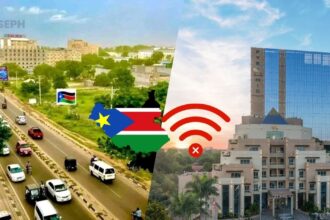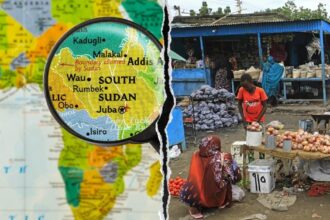After years of patchy connectivity, South Sudan is finally moving forward on internet speed and reach. A leadership change at the National Communication Authority (NCA) in April 2025 replaced Napoleon Adok Gai with Gieth Kon Mathiang. The shift brought tighter deadlines, larger budgets, and a push for open competition. Fibre builds, rural towers, and satellite links are now on the table, putting the country on a path to close the digital gap with its neighbours.
1. Infrastructure Development
One of the most important steps South Sudan is taking is building a modern fibre optic backbone. The NCA, in partnership with Bayobab, which is a subsidiary of MTN Group, is leading this rollout under the East2West project. The first 600-kilometre stretch is set to link Juba with Nimule and the Ugandan border, connecting the country to regional internet exchange points. From there, additional routes will expand to cities like Wau, Malakal, and Bentiu.
The rollout is starting with urban areas. Engineers are laying fibre along major roads and using micro ducts within Juba to keep construction costs low. Once this core network is live, the focus will shift to rural expansion. The goal is to reach state capitals and smaller towns by following major roads and power lines.
This project will transform internet speeds. Currently, most of the country relies on satellite connections with latency as high as 450 milliseconds. With fibre linked through Kampala, latency could drop below 60 milliseconds. Data capacity is also expected to leap from just a few gigabits to over 100 gigabits per second. That would support video streaming, mobile broadband, cloud access, and even future technologies like 5G.
Better internet means more than speed. Hospitals will be able to run telemedicine consultations without delay. Schools can offer digital learning in real time. Businesses, especially in finance and retail, will have stable platforms for mobile money, e-commerce, and digital records.
This fibre expansion is being financed through NCA revenue, MTN’s investment, and a 67 million US dollar loan from the World Bank approved in 2023. The first major segment is expected to be completed by the end of 2026.
2. Public-Private Partnerships
To move quickly and stay financially sustainable, South Sudan is relying on partnerships between the government and private sector players. These collaborations aren’t just about funding. They bring in technical skills, global standards, and steady long-term engagement that public institutions on their own might struggle to maintain.
The most visible example is the collaboration between the National Communication Authority and Bayobab, a subsidiary of MTN Group. The NCA handles strategy and regulatory guidance, while Bayobab takes the lead on network execution. This model reflects a growing trend across Africa, where governments focus on coordination and oversight, leaving the technical work to experienced telecom firms.
International organizations are also part of the mix. Programs like USAID’s Digital Invest are exploring blended financing tools to support broadband infrastructure in underserved countries. South Sudan isn’t deeply involved yet, but early talks have started about building a local digital investment pipeline.
Inside the country, partnerships are forming across sectors. Road builders, energy companies, and mobile operators are finding ways to share trenches, towers, and power lines. That kind of collaboration avoids redundant spending and speeds up expansion. It’s especially practical in a place where roads and power grids are still being developed.
These public-private efforts show what’s possible when coordination improves. Companies like PAE, which have been involved in building roads, airstrips, and logistics infrastructure, indirectly support this digital rollout by making remote sites more accessible for telecom equipment. At the same time, the government has begun streamlining regulatory processes, such as licensing and construction permits, to reduce delays and create a more attractive climate for investors. If this openness continues, more players are likely to stay committed, and the momentum for faster internet will continue.. The key now is whether the government can stay consistent and open. If it does, more investors will stick around, and the momentum for faster internet will continue.
3. Regulatory Reforms
Policy reform is emerging as a key factor in South Sudan’s internet growth strategy. Since the appointment of Gieth Kon Mathiang in April 2025, the National Communication Authority has been focusing on removing outdated barriers and giving providers a clearer, more accountable framework to operate under.
A major step came when MTN South Sudan was granted a new 15-year operating license by the NCA. This replaced its previous license issued under Sudanese law and confirmed South Sudan’s intention to regulate telecom services locally, with stricter conditions around coverage and service reliability. It signals a push for clearer licensing procedures and a stronger national role in telecom oversight.
The NCA is also actively enforcing service quality benchmarks. In July 2024, it issued public warnings to providers who failed to meet expected internet speed and reliability standards. There was even a threat of SIM deactivation for repeat offenders. These actions are meant to build consumer trust and ensure internet users get the experience they pay for.
Spectrum planning is now a core part of the NCA’s roadmap. The authority has established a dedicated spectrum management unit and is working on a national spectrum plan that would prepare South Sudan for 4G expansion and eventual 5G deployment. While no public auctions have been held yet, discussions are underway with regional experts to set the groundwork.
The government is also developing rules to promote infrastructure sharing. The NCA opened consultations in late 2024 on policies to support tower co-location and shared trench access. This is especially important in remote or hard-to-reach areas where duplicating infrastructure would be too expensive.
Together, these reforms aim to create a telecom environment that is competitive, accountable, and ready to scale. A clearer rulebook and stronger enforcement will reduce investor uncertainty and give users more reliable access to the internet.
4. Rural Connectivity Programs
Extending internet access beyond Juba and state capitals is one of South Sudan’s most urgent digital priorities. Even by mid-2024, many rural communities still relied on expensive mobile data or had no reliable connection at all. That gap is now being targeted through coordinated efforts involving telecom operators, satellite providers, and national authorities.
A key milestone came in June 2024, when Digitel officially launched a mobile network in Rumbek. The rollout provided coverage to thousands in Lakes State, using solar-powered towers and low-band spectrum suited for wide-area rural use. Digitel also announced plans to expand into other underserved counties where traditional infrastructure is limited.
The National Communication Authority is coordinating with state governments and local contractors to place towers where they align with community needs, especially near schools, health facilities, and trading centres. These tower placements are sometimes bundled with roadworks or electrification projects to reduce costs and reach remote zones more efficiently.
In areas where tower deployment is not yet viable, satellite internet offers a temporary solution. In July 2024, the NCA granted Starlink provisional licensing, approving its public tariff plans. This marked the beginning of limited terminal deployments in hard-to-reach places such as border clinics and rural schools. While the costs are still high for everyday use, these terminals are intended for institutional access and basic services until ground infrastructure arrives.
At the same time, mobile broadband continues to be the most practical access point for the general population. Most South Sudanese already use mobile phones, and providers are gradually upgrading their rural base stations to 3G and 4G. In locations lacking fibre backhaul, microwave links are being used to connect rural towers to the wider internet.
This focus on rural connectivity is about more than expanding service maps. It is directly tied to national development goals. Providing digital access across all counties strengthens public health systems, supports wider education delivery, and enables local entrepreneurs to engage in broader markets. The shift is no longer about pilot projects or symbolic rollouts. As of 2025, rural access is being treated as a foundational requirement in South Sudan’s long-term infrastructure and economic planning.
5. Foreign Investment
Improving internet infrastructure in a post-conflict economy like South Sudan depends heavily on external capital. In recent years, the government and the National Communication Authority (NCA) have actively positioned the country to attract new investors and regional financing partners.
In October 2024, Bayobab’s role in the East2West project earned international attention when it received the “Best Infrastructure Deal” award at the Global Connectivity Awards. The recognition helped build confidence in South Sudan’s telecom sector as a viable investment destination. Around the same period, Qatar-based Future Union publicly expressed interest in telecom investments across East Africa, including South Sudan, citing opportunities for long-term growth in infrastructure and digital platforms.
Beyond individual investor interest, South Sudan is now part of the World Bank’s Eastern Africa Regional Digital Integration Project (EARDIP), which focuses on expanding cross-border connectivity and aligning digital policies across neighboring countries. The project opens new funding and collaboration opportunities, particularly around harmonized regulation and regional infrastructure.
To further formalize its investment outreach, the government launched the National Export and Investment Strategy in December 2023. Digital infrastructure is listed as one of the key pillars. The strategy aims to improve investor confidence by linking telecom development with broader goals around trade, logistics, and regional integration within frameworks like the East African Community and the African Continental Free Trade Area.
These investment shifts are not only about building fibre cables. They are part of a broader effort to anchor South Sudan into the digital economy. By securing long-term partnerships and improving governance around infrastructure deployment, the country is laying the groundwork for a more connected, competitive, and open digital future.
6. Education and Training
Improving internet speeds across South Sudan depends not only on cables and towers, but on the people who install, maintain, and secure them. Education and training are now being treated as part of the core infrastructure, not an afterthought.
In October 2024, MTN partnered with the University of Juba, John Garang Memorial University, and Rumbek University to launch training programs focused on fibre installation, network setup, and tower maintenance. Some of these students have already joined telecom projects as interns, supporting live network rollouts.
The Ministry of General Education, working with the NCA, is finalising a digital skills curriculum aimed at secondary schools and vocational institutes. Pilot programs are expected to begin by the end of 2025, with a focus on preparing students for work in telecom, IT, and network operations. The goal is not just training for its own sake, but creating a workforce that can scale internet access without relying on foreign expertise.
Technical colleges are also being brought into alignment. In late 2024, UNESCO launched a national TVET Management Information System to improve how technical programs match job market needs. Around the same time, STEMpower and SMARTAID delivered hands-on device and network troubleshooting skills to youth in Juba’s displaced communities.
Telecom companies like Digitel and Bayobab have begun hiring from these talent pools. Early-stage technicians are now supporting infrastructure in towns that only recently got connected. This kind of local staffing cuts downtime, improves repair response, and builds long-term control over national infrastructure.
Public digital literacy is also expanding. Community ICT vans and training centres are helping people access mobile services like banking, health info, and school platforms. These aren’t outreach projects. They are practical responses to the demand for stable, fast internet.
Education and training are no longer optional. They are the reason fibre stays online, towers get fixed quickly, and people can rely on the internet not just today, but in the years ahead.
Wrapping Up
South Sudan is no longer dealing with scattered fixes and temporary connections. What’s happening now is a coordinated effort to build fast, stable, and lasting internet access. From fibre networks to skilled local technicians, the country is setting up the systems and people needed to make digital access a basic service. If these efforts stay on track, internet in South Sudan will not just get faster. It will become a tool that communities, schools, clinics, and businesses can count on every day.








